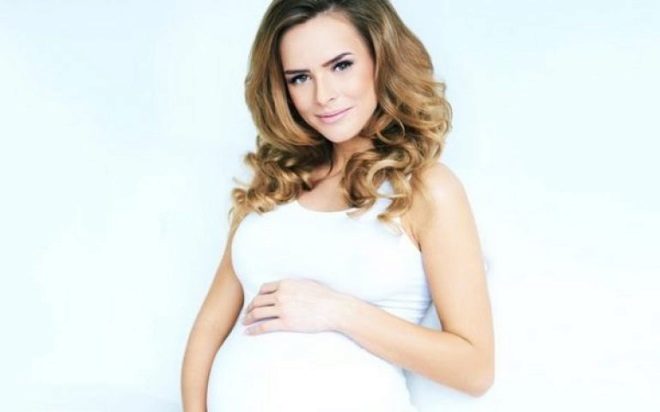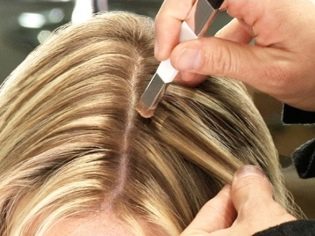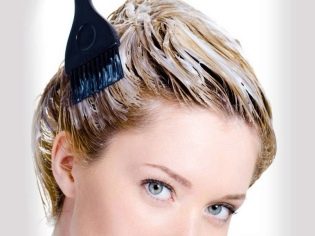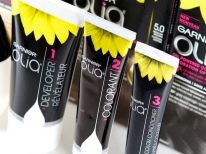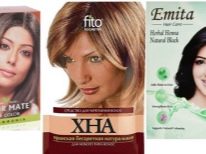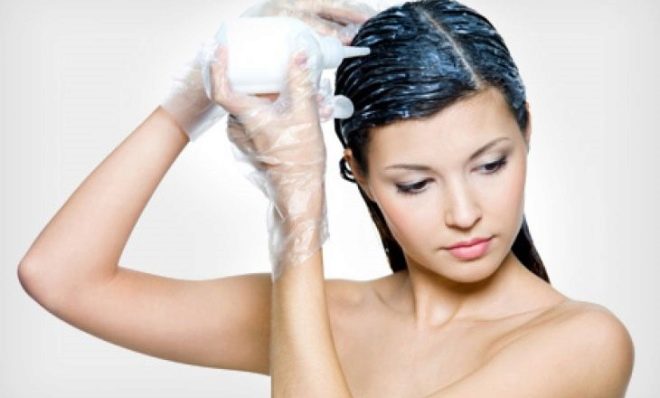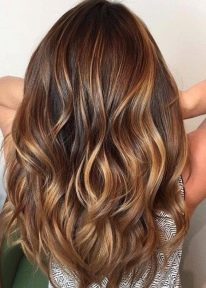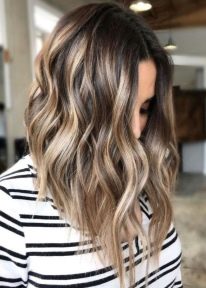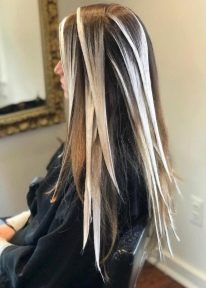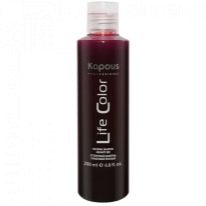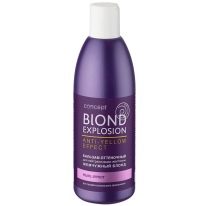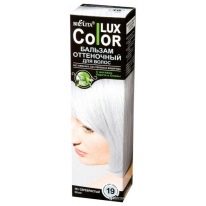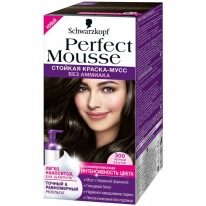Can I dye my hair during pregnancy? Opinions of doctors
Modern women dye their hair as easily as they do their morning makeup. It has become the norm of life. But in the period of childbearing, women become more suspicious, restless, and there is nothing surprising in the fact that a reasonable question arises - is it not dangerous staining, because the cosmetics intended for this often have an unbearable pungent odor and a chemical-rich composition.
What is dangerous?
From the first days after conception to the very birth, a lot of changes occur in the body of the future mother - from external and obvious to invisible, internal ones, which relate to changes in hormonal background and metamorphosis with metabolic processes.
It is the ratio of progesterone - pregnancy hormone to estrogen - female sex hormones that determines the condition of the future mother's hair. In this case, in different trimesters of pregnancy, this effect is different.
- First trimester Progesterone and chorionic gonadotropin predominate in the body. This combination of hormones does not contribute to improving the quality of female hair. If at the same time a woman suffers from severe toxemia, then the hair becomes thinner due to the lack of trace elements and vitamins, they become drier, brittle, dull.
- Second trimester Relief comes, well-being improves markedly, but the fetus's need for calcium increases due to the onset of mineralization of the bones of the child’s skeleton. If calcium is not enough, the condition of the hair will be completely deplorable. If, however, in time to add to the diet foods rich in calcium, the condition of the hair begins to improve - by the middle of the trimester, they are usually shiny, strong.
- Third trimester There is an active growth of the fetus and weight gain, it produces growth hormones that also affect the growth of mother's hair - they begin to grow faster, which is especially noticeable on dyed hair, whose roots are rapidly growing. By the end of the trimester, the level of estrogen rises.
In any of the trimesters, a woman has a question whether hair can be dyed if they have lost their color, shine or grown too much. To answer this question, you need to take into account several important factors.
- The influence of the chemical composition of hair dye products has not been studied in clinical trials, and therefore the effect on the fetus is not known for certain. When such a situation arises, the doctors "by default" recommend to abandon what acts in an unknown and unobvious way. This is due to the majority of prohibitions on painting hair. At the same time, doctors do not deny the possibility of staining with natural means, for example, henna.
- In the first trimester, the organs and systems of the fetus are laid out, and any negative factor can disrupt the subtle cellular processes, and therefore the ban on staining in the first third of the term for carrying a baby looks quite reasonable and reasonable.
- In paints with ammonia dyes there is an essential minus - they smell very unpleasantly, badly affect the state of the respiratory system. All cosmetics with ammonia in the composition should be excluded during childbirth, and the coloring itself should be carried out only in a room that is well ventilated.
- During pregnancy, immunity is significantly reduced and the metabolism changes, and therefore during the seemingly familiar hair dyeing procedure increases the likelihood of a severe allergic reaction. An inadequate immune response is quite capable of developing even on the dye, with which the woman quite safely dyed her hair for a long time before pregnancy.
- Due to global endocrine metamorphosis staining effect may be completely unexpected - in particular, the color is not always the one that was declared. Paint may lie unevenly - spots, stripes.
In general, the harm and benefit of staining while waiting for a child should be considered on an individual basis. You can dye your hair, but not all formulations and not all pregnant women. For example, with a strong deterioration of the hair due to pregnancy, it is not necessary to aggravate their already deplorable state by staining.
Studies conducted by specialists from the Southern California Medical Academy have shown that the risk of developing cancer is almost three times higher in women who dye their hair more often than 5 times a year. As for the effect on the fetus, there are still a lot of questions. It is known that substances from the composition of paints can theoretically penetrate the placental barrier, but only on condition that they are present over a large area and are in long contact with the skin of a woman.
The presence of ammonia in a cosmetic can lead to severe headaches, nausea, and vomiting. Hydrogen peroxide in the composition can cause chemical burns of the mucous membranes, as well as act as an allergen. Parabens cause inflammation of the nasopharynx. Dihydroxybenzene, being a variant of phenol, has properties to accumulate in the body and act as a toxin. Phenylenediamine has a toxic effect on the kidneys, lungs, immunity. Persulfates are dangerous to the respiratory system. Lead acetate is toxic to the brain and nervous system, and also especially dangerous to the fetal nervous system. Both formaldehyde and ethanolamine, which can be found in at least half of hair dyes, are also dangerous.
If you dye your hair without affecting the skin of the head (there are such techniques), then the risk to the fetus can be minimized.
Contraindications
In the early stages of pregnancy up to 13 weeks inclusive, it is not recommended to dye hair at all. This is the period of organogenesis, when all organs and systems form in the fetus. The opinion of doctors on this is unambiguous - if it is possible to avoid a possible risk factor, it is better to avoid it without exposing the child to danger. Especially dangerous up to 10 weeks inclusive. But during the entire first trimester, it is better to refrain from such experiments. No one says that it is impossible to be painted, no one puts tough bans, but all the doctors point out that this is at least harmful and at the most dangerous.
The second trimester does not imply such a rigid framework, and a woman, if necessary, can use hair dyeing, but with the use of benign non-ammonia dyes. The third trimester is divided into two conditional periods - at the beginning from week 27 to week 34, staining is allowed subject to precautions, but after this period, the placenta begins to age rapidly, its barrier functions diminish, and therefore staining in late periods, in the last weeks of 9 months pregnancy is not recommended again.
It is not necessary to dye the hair during the term of carrying a baby to women who suffer from various forms of allergic reactions, as well as to women with endocrine diseases in history.
How to reduce the risk?
All of the above does not mean that a woman needs to walk with untidy regrown roots and look forward to giving birth in order to finally put her appearance in order. Precautions can help reduce potential risks:
- staining from the second trimester of pregnancy, not earlier;
- you should not dye your hair too often, the recommended frequency of the procedure is 1 time per trimester;
- for dyeing, choose semi-professional paints or natural dyes - they are, of course, less persistent, but less harmful;
- You should not choose the cheapest means for coloring - in cheap paints often there are hazardous salts of heavy metals;
- carefully consider the packaging of the paint and familiarize yourself with the composition - if ammonia, dihydroxybenzene, aminophenol and phenylenediamine, formaldehyde and other toxic substances listed above are detected in it, refuse to purchase such a product.
The best option for the future mother will be the procedure of organic staining.
This procedure is not the cheapest, but safer, since it uses cosmetics, 90% of which are made from natural ingredients.
When contacting a beauty salon, be sure to inform the master of his "interesting" position. An experienced specialist will take into account the selection of tools for staining. If the beauty salon is not included in the plans and the woman is going to dye her hair on her own, it is important to carefully read the instructions attached to the dye so as not to overdo the product on the hair more than the time specified by the manufacturer.
When painting, be sure to wear gloves to prevent skin contact with the dye. The test for allergies, which women often neglect, should be carried out during pregnancy without fail, because even paint that has never caused harm during gestation can become an allergen. The test is easy, you can cope with this task without special medical knowledge: dissolve a little of the composition, apply on the back of your hand, hold for 20 minutes, rinse and observe for an hour - if the place of application is not red, not swollen, not covered with rashes, then it is possible to be painted with this means.
Do not forget to provide good ventilation in the room where you will dye your hair. You can also use a gauze bandage or a pharmacy respirator to protect your respiratory organs.
Among the ways of coloring you should pay attention to more gentle balayazh, coloring, highlighting and ombre - with them there is no need to apply the paint directly from the roots over a large area, which will exclude the contact of the paint with the skin of the scalp.
What can paint?
Choose a safe method of coloring - half the success. On the shelves of shops you can find a variety of tools for changing hair color, and this only complicates the choice of the future mother. Brunettes and ginger are perfect different options for henna. You can also use a decoction of the most ordinary pharmacy chamomile or oak bark, Basma.
Pay attention to tonic colors, shampoos and balms - they do not provide a long lasting effect from painting, but they will also be the least harmful. You can use such tools more often than hair dyes, and therefore a woman can maintain her hair in a tidy condition without problems. The downside is that the dyeing component is so weak and untenable that it can leave ugly soiling stains on the collar of a shirt or blouse, on a pillow, on a hat, absolutely until it is washed off the hair.
Natural herbal remedies do not tolerate inaccuracies. Check out the main hair color to try to get into the tone.
A decoction of chamomile for brunettes and brown-haired women is not suitable at all, it will be indistinguishable on dark hair, but it gives a golden shade and a mild lightening effect to fair-haired blond women. Blondes You can consider the option of lemon juice. It slightly brightens and dries hair that is too greasy (women often suffer from oily hair in the third trimester of pregnancy due to increased estrogen production).
Brunettes oak bark will do.If you brew a strong decoction, you can profitably shade brown hair and give them a golden hue.
Brown-haired You can also cope with the task with the help of the well-known natural dye, which is used for dyeing eggs for Easter - onion peel. In combination with the brewing of black tea, the husk will give a golden chestnut color.
Basma will be useful to brown-haired women and brunettes, and natural henna - redheads. A decoction of walnut shell will give a chestnut-copper hue.
Blondes with regrown roots are most difficult - lightening agents are undesirable. It will be necessary either to repaint with a shampoo in the color of the regrown roots, or to wait with the color correction of the roots until the postpartum period.
Organic staining is carried out by means which consist of not less than 9/10 of natural components. When choosing a non-ammonia paint, it should be understood that such a staining agent will have its advantages as well as its disadvantages. Undoubtedly, the absence of ammonia saves women from the need to inhale unpleasant vapors of chemical origin. Such paints have a more delicate effect on the structure of the hair, they have natural shades, they lie evenly. But at the same time, they do not guarantee long lasting color, and they are quite expensive.
It is important to know that the absence of ammonia in itself is not the key to the safety of the product, since other chemicals whose effect can hardly be called useful may well be present in the paint classified as ammonia-free.
And this makes it difficult to use during pregnancy: to maintain color, dyeing means without ammonia must be done quite often, and some components of such paints may not be fair.
The question of which colors are acceptable for use during pregnancy is difficult to answer unequivocally, but the feedback from women shows that, most often, future mothers choose such means as:
- Garnier "Color Shine";
- Estel Professional "Deluxe Sense";
- SanoTint;
- Wella "Color Touch";
- Schwarzkopf "Perfect Mousse";
- Matrix;
- L'Oreal Casting Creme Gloss;
- Schwarzkopf "Essential Color".
Important! If, before pregnancy, a woman never dyed her hair, then the period of carrying a child is not the best time to start experimenting with appearance.
This procedure is rather a forced measure, and therefore it is better not to start painting at this time. Also not recommended cardinal repainting of a blonde in a burning brunette, or vice versa.
See whether you can dye your hair during pregnancy in the next video.

